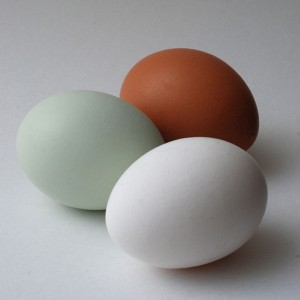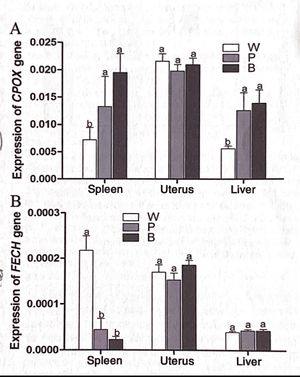Genetics of Egg Color in Chickens: Difference between revisions
| Line 57: | Line 57: | ||
There is speculation over how protoporphyrin is derived in chickens. Researchers generally ascribe to one of two views. | There is speculation over how protoporphyrin is derived in chickens. Researchers generally ascribe to one of two views. | ||
Protoporphyrin is derived from blood heme. Scientists who support this theory argue that the protoporphyrin originates from either free circulating erythrocytes or as a metabolite from the heme that is released from dying erythrocytes. | |||
Protoporphyrin is synthesized in the shell gland. Researchers have found previously free heme, protoporphyrin, and biliverdin in sufficient quanity in the shell gland of laying hens. This, along with the presence of protoporphyrin precursor enzymes in shell gland, supports their position. <ref> S. Samiullah, J. R. Roberts, K. Chousalkar, Eggshell color in brown-egg laying hens — a review, Poultry Science, Volume 94, Issue 10, October 2015, Pages 2566–2575, https://doi.org/10.3382/ps/pev202 </ref> | 1. Protoporphyrin is derived from blood heme. Scientists who support this theory argue that the protoporphyrin originates from either free circulating erythrocytes or as a metabolite from the heme that is released from dying erythrocytes. | ||
2. Protoporphyrin is synthesized in the shell gland. Researchers have found previously free heme, protoporphyrin, and biliverdin in sufficient quanity in the shell gland of laying hens. This, along with the presence of protoporphyrin precursor enzymes in shell gland, supports their position. <ref> S. Samiullah, J. R. Roberts, K. Chousalkar, Eggshell color in brown-egg laying hens — a review, Poultry Science, Volume 94, Issue 10, October 2015, Pages 2566–2575, https://doi.org/10.3382/ps/pev202 </ref> | |||
Revision as of 02:15, 2 December 2019
Introduction
Zora Mosley
Chickens lay eggs in a variety of colors: white, brown, olive, green, blue, and many shades in between. Although shell color does not affect nutrition or taste, egg color is economically important to poultry and egg industries due to consumer preferences. The color of a chicken's egg depends on their genetic makeup. This wiki-page will explore the genetics behind egg color in chickens, specifically focusing on white, brown, and blue eggs. Three pigments are known to be responsible for the color of chicken eggshells: protoporphyrin, biliverdin, and biliverdin-zinc chelate. White eggs tend to have very little protoporphyrin, but in brown eggs, the main pigment is protoporphyrin.[1] Blue egg color is a bit more complex. The blue egg phenotype arose only 200-500 years ago in South American Mapuche fowl. Recent research has shown that blue egg color in chickens is actually due to an ancient retrovirus that copied itself into the chicken's genome.[2] Source: https://onlinelibrary-wiley-com.libproxy.kenyon.edu/doi/abs/10.1111/asj.12182 Source 2: https://www.sciencedaily.com/releases/2013/08/130820083654.htm
Select a topic about genetics or evolution in a specific organism or ecosystem.
The topic must include one section about microbes (bacteria, viruses, fungi, or protists). This is easy because all organisms and ecosystems have microbes.
Compose a title for your page.
Type your exact title in the Search window, then press Go. The MicrobeWiki will invite you to create a new page with this title.
Open the BIOL 116 Class 2019 template page in "edit."
Copy ALL the text from the edit window.
Then go to YOUR OWN page; edit tab. PASTE into your own page, and edit.

At right is a sample image insertion. It works for any image uploaded anywhere to MicrobeWiki. The insertion code consists of:
Double brackets: [[
Filename: PHIL_1181_lores.jpg
Thumbnail status: |thumb|
Pixel size: |300px|
Placement on page: |right|
Legend/credit: Electron micrograph of the Ebola Zaire virus. This was the first photo ever taken of the virus, on 10/13/1976. By Dr. F.A. Murphy, now at U.C. Davis, then at the CDC.
Closed double brackets: ]]
Other examples:
Bold
Italic
Subscript: H2O
Superscript: Fe3+
Section 1 Genetics Behind White and Brown Eggs
Protoporphyrin is the primary pigment responsible for brown eggs’ coloration. Traces of biliverdin and zinc chelates are also found in brown eggshells and affect coloration.[3] White eggs have very little protoporphyrin. Thus the coloration of white and brown eggs is directly tied to the secretion and deposition of protoporphyrin. Researchers have so far identified seven genes that are involved in eggshell color: CPOX, FECH, BCRP, HRG1, FLVCR, SLCO1A2, and SLCO1C1. Careful study and research have yielded the following conclusions:



-High expression of CPOX gene results in more protoporphyrinogen and a brown shell color.
-High expression of FECH gene (which is speculated by some scientists to convert protoporphyrinogen into heme) results in reduced protoporphyrinogen levels and lighter eggshell color.
-High expression of heme transporter BCRP is associated with brown eggshell color.
-High expression of heme transporter HRG1 is associated with white eggshell color.
-High expression of heme transporter FLVCR is associated with generally lighter eggshell colors.
-High expression of both genes SLCO1A2 and SLCO1C1 are associated with brown eggshell color. [4]
Even though, researchers have identified the above seven genes, the genetic control of the synthesis and deposition of brown pigment is not fully understood.
There is speculation over how protoporphyrin is derived in chickens. Researchers generally ascribe to one of two views.
1. Protoporphyrin is derived from blood heme. Scientists who support this theory argue that the protoporphyrin originates from either free circulating erythrocytes or as a metabolite from the heme that is released from dying erythrocytes.
2. Protoporphyrin is synthesized in the shell gland. Researchers have found previously free heme, protoporphyrin, and biliverdin in sufficient quanity in the shell gland of laying hens. This, along with the presence of protoporphyrin precursor enzymes in shell gland, supports their position. [5]
Sample citations: [6]
[7]
A citation code consists of a hyperlinked reference within "ref" begin and end codes.
Section 2 Genetics Behind Blue Chicken Eggs
Include some current research, with a second image.
Section 3 Nature vs. Nurture
Conclusion
Overall text length should be at least 1,000 words (before counting references), with at least 2 images. Include at least 5 references under Reference section.
References
- ↑ Zheng, C. , Li, Z. , Yang, N. and Ning, Z. (2014), Candidate Genes Affecting Eggshell Color. Animal Science Journal, 85: 506-510. doi:10.1111/asj.12182
- ↑ University of Nottingham. "Unscrambling the genetics of the chicken's 'blue' egg." ScienceDaily. ScienceDaily, 20 August 2013. <www.sciencedaily.com/releases/2013/08/130820083654.htm>.
- ↑ S. Samiullah, J. R. Roberts, K. Chousalkar, Eggshell color in brown-egg laying hens — a review, Poultry Science, Volume 94, Issue 10, October 2015, Pages 2566–2575, https://doi.org/10.3382/ps/pev202
- ↑ Zheng, C. , Li, Z. , Yang, N. and Ning, Z. (2014), Candidate Genes Affecting Eggshell Color. Animal Science Journal, 85: 506-510. doi:10.1111/asj.12182
- ↑ S. Samiullah, J. R. Roberts, K. Chousalkar, Eggshell color in brown-egg laying hens — a review, Poultry Science, Volume 94, Issue 10, October 2015, Pages 2566–2575, https://doi.org/10.3382/ps/pev202
- ↑ Hodgkin, J. and Partridge, F.A. "Caenorhabditis elegans meets microsporidia: the nematode killers from Paris." 2008. PLoS Biology 6:2634-2637.
- ↑ Bartlett et al.: Oncolytic viruses as therapeutic cancer vaccines. Molecular Cancer 2013 12:103.
Edited by [Author Name], student of Joan Slonczewski for BIOL 116 Information in Living Systems, 2019, Kenyon College.
